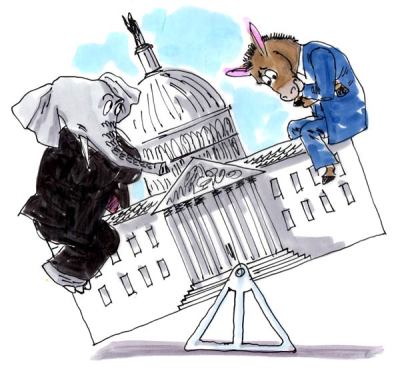What Is a Wave In the Senate?

For several months, we've held steady on our range of expected gains for Republicans in the Senate: a net of four to eight seats. With Labor Day in the rearview mirror and with less than 55 days to go until the midterms, we're giving Republicans a slight bump: Our new range is a Republican net of five to eight Senate seats.
This means that the best-case scenario we can now envision for Democrats is a 50-50 tie in the Senate, with Vice President Joe Biden's tiebreaking vote narrowly keeping Sen. Harry Reid (D-NV) as majority leader.
The likeliest outcome remains a Republican gain of six or seven seats, which we noted before Labor Day and stand by now. That would be good for a narrow 51-49 or 52-48 Republican Senate majority.
What's changed? Not a whole lot: It's just that the weight of an unpopular president in the White House and a GOP-leaning Senate map is subtly moving things a tick or two in the Republican direction.
We do have one major rating change this week: Arkansas is going from Toss-up to Leans Republican. We had Sen. Mark Pryor (D-AR) as an underdog earlier this cycle, and we're putting him back there now based on the growing weight of polling data. If one assumes Republicans will net Montana, South Dakota, and West Virginia, they need at least two more seats to meet the low end of our range. Arkansas looks like the next domino to fall, and if that comes to pass, the GOP will have netted four seats. (More on this in our race-by-race analysis below.) Given the wide range of other targets for Republicans in the Senate — Alaska, Colorado, Iowa, Louisiana, and North Carolina, with other conceivable but more remote possibilities in Michigan, Minnesota, and New Hampshire — it seems reasonable to expect that the GOP will net at least one more assuming they don't lose any of their current seats. Hence the new range.
Given that Republicans are poised, we believe, for substantial Senate gains, we're wondering: What would count as a "wave" for the GOP in the Senate?
As emeritus Prof. Al Tuchfarber of the University of Cincinnati wrote in the Crystal Ball last week, waves have a "very specific semi-formal definition" from a political science standpoint, which is that one party or the other nets 20 or more seats in the House. By that definition, the GOP is likely to fall short this year, if only because they are close to being maxed out in the House. (We project the Republicans to gain five to eight House seats, coincidentally identical to the new Senate projection.)
But there's no wave definition for the Senate, probably because the Senate is so idiosyncratic: Only a third of the seats are up every two years, and each class alternates between being contested in bigger-turnout presidential years and smaller-turnout midterm years.
Jacob Smith, a political science graduate student at the University of North Carolina, has an interesting take on this. In his senior honors thesis for Kenyon College, he researched the idea of a wave election and came up with this definition: A wave year is "a congressional election that produces the potential for a political party to significantly affect the political status quo as the result of a substantial increase in seats for that party." (We encourage readers to read his deeper explanation.)
By his calculation, Smith argues that a six-seat gain for the GOP in the Senate (likelier than not, and Smith freely admits that defining waves in a standard way in the Senate is quite challenging) and a 26-seat gain in the House (not very likely) would make 2014 a wave year. Previous wave years by this definition since World War II are: 1946, 1948, 1958, 1964, 1966, 1974, 1980, 1994, 2006, and 2010.
Note that 1986, a year when Democrats gained eight Senate seats and five House seats, is not included here. We've often compared 1986 to 2014; in 1986 President Reagan had his "sixth-year itch" that featured a great Democratic Senate map much like this year's excellent Republican map.
Republicans can net up to seven Senate seats by simply winning all of the states on this year's map where there is currently a Democratic senator representing a state won by Mitt Romney in 2012. Earlier this year, we called such an outcome "gale force white caps," meaning a great stirring of the political seas that fell short of a "wave," politically speaking, because Republicans would essentially just be winning in states where one would expect them to win in a Republican-leaning year with a Democrat in the White House. It would be more of a "correction" in this era of polarization than a wave. Thus, we're defining a "wave" in the Senate this year as such:
Republicans need to: (1) Win control of the Senate and (2) Win at least one seat in a state won by President Obama in 2012 (most likely Colorado or Iowa).
All of these comments are worthwhile, and they suggest that, unless the GOP truly sweeps on Nov. 4, we're going to have a vigorous debate about whether there was a wave or not.
You might be saying: "Who cares? This is all semantics." Not really. This midterm election should be interpreted in light of the broader shifts in U.S. politics being driven by demographics (the growth of the minority vote percentage, the tilt of voters under 30 to Democrats because of their racial makeup and social issues, and the transformation of the political map as seen in 2008 and 2012, with states such as Colorado, Florida, Nevada, North Carolina, and Virginia becoming purple or blue, and the border states of Arkansas, Kentucky, Tennessee, and West Virginia becoming very red). As long as a presidential election features strong, competitive nominees in both major parties, Democrats start out with a sizable head start in the Electoral College. A Democrat need win only a few purple states to reach 270 electoral votes, but a Republican has to thread the eye of many purple needles to take the White House.
Therefore, nonpartisan analysts will look to see whether Republicans have made up ground in 2014 in key swing districts and states. How many Obama states and districts have voted GOP for senator or representative? (Gubernatorial battles are in a different category for lots of reasons.) If Republican candidates are just winning red states, then it means that the entire burden for a breakthrough falls on the party's 2016 presidential nominee. And let's also keep in mind that the lower, GOP-heavy midterm turnout (lower minority and youth proportions, higher white and older percentages) very probably won't be any kind of mirror of the 2016 turnout.
Republicans proved in 2010 they could win big in a midterm year. That year undeniably featured a large wave — and look what it got the GOP in 2012. It very well may be that 2014 will show again that the GOP can triumph in a midterm during the Obama era. But the relationship between the midterm results and the next White House battle will be tenuous once more unless we see some real surprises in about seven weeks.
A quick Senate overview
As the election approaches, we're starting to get more high-quality polling in some of the key races. As Table 1 shows below, many of the races remain quite close. In addition to our race ratings, we're also showing where the polls stand right now, based on the two polling averages we consult most frequently, HuffPost Pollster and RealClearPolitics.
See Table 1 here.
As mentioned above, we're changing Arkansas from Toss-up to Leans Republican. Nonpartisan polls there are starting to show a lead for Rep. Tom Cotton (R-AR), who is challenging Sen. Mark Pryor (D-AR). Since July, the only polls to show a Pryor lead are either Democratic internals or a single Rasmussen Reports survey, which had Pryor up a point. Democrats hope an investment in their ground game can help here, but in a state where Mitt Romney won close to 61% of the vote in 2012 and where there are relatively few minority voters (compared to other Republican-leaning Southern states) to turn out, Cotton has to be viewed as a small favorite here, even though Pryor is definitely still in the game.
Our four Toss-ups — Alaska, Iowa, Louisiana, and North Carolina — are harder to pin down, although Louisiana is probably still the likeliest to be the fifth Democratic state to flip, getting the GOP to the low end of our five-to-eight seat projection.
We've stubbornly held Colorado as a Leans Democratic state, and Sen. Mark Udall (D-CO) now has a slightly bigger lead than he's had before, although Democrats worry that President Obama's low numbers in the Centennial State will drag down both Udall and Gov. John Hickenlooper (D-CO).



























